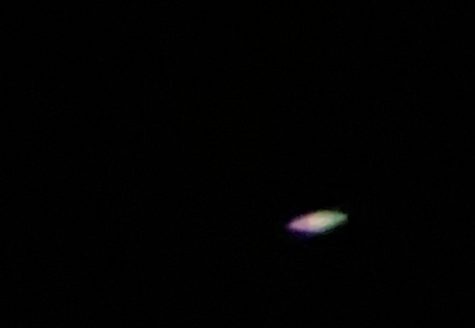A Once-in-a-Lifetime Event: Astronomy Club views Jupiter at its Closest Approach to Earth in 59 Years
Photo of Jupiter and the four Galilean Moon (from left to right: Ganymede, Europa, Io, and Callisto) taken during the Astronomy Club meeting. Photo by Ellie Shin.
October 6, 2022
Between 8:50 and 10:40 pm, a small group congregated on Reynolds Field, their heads cocked skyward into the seemingly black abyss. It was a crisp, clear night, with few clouds in the sky and a new moon casting no ambient light. An evening like this could play host to many events, but in the case of Monday, September 26, the Astronomy Club took advantage of these prime conditions to host an informal club viewing of the planet Jupiter. With low winds allowing for excellent telescope stability, viewing the gas giant — the largest planet in the solar system — was a simple task, especially considering it appeared as the brightest celestial body in the sky. The reason behind its impressive luminescence: Jupiter was at its closest position to Earth since 1963.
Since Jupiter and the Earth have different orbits around the Sun, when they pass, their distance from one another is variable each time. On September 26, the two planets came closer than they had for the past 59 years, being “only” 367 million miles apart. As a reference, Jupiter, at its farthest from Earth, is 600 million miles away. Jupiter’s incredible proximity was coupled with another event that helped augment its brightness and size in the night sky: opposition. Planets in opposition are in direct alignment with the Earth and the Sun, with the planet and the Sun straddling Earth. Jupiter’s opposition also occurred on the evening of September 26, and since opposition causes plants to look brighter and larger, it only aided the spectacle of the evening.
For the roughly 20 students who showed up for the event, which technically was not a formal Astronomy Club meeting, they were treated to excellent views of Jupiter’s banding, the beige and reddish stripes that color the planet, and its four Galilean moons — Ganymede, Europa, Io, and Callisto. Also known as the Galilean Satellites, these are Jupiter’s four largest moons (of an impressive 72) and the only one’s visible with basic astronomical equipment. Adding to the excitement of the night, this was a once-in-a-lifetime event for those who were present since Jupiter won’t be this close to the Earth again until 2129, in about 127 years!
Although the goal of the evening was to study and view Jupiter, the Astronomy Club took the opportunity to view a few other fun astronomical bodies and phenomena. As Saturn was also particularly easy to spot with clear skies and no moonlight, seeing its famous rings was a fun addition to the night, especially as many who attended had never seen the ringed planet before. Two shooting stars, including one that was fairly low, and nice views of Ursa Minor (the Little Dipper) and Vega, the brightest star in the constellation Lyra, all capped another fantastic Astronomy Club evening.
Astronomy Club will be formally meeting next sometime in early October, with a guaranteed viewing of the Hunter’s Moon on October 9th and a possible viewing of the Draconids Meteor Shower on October 7th.



















